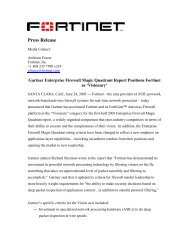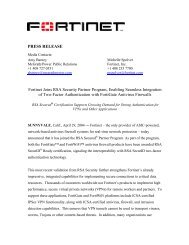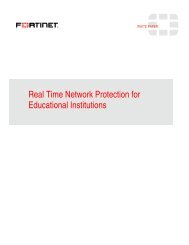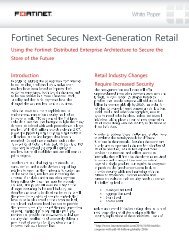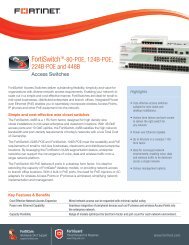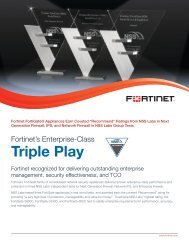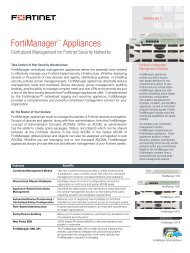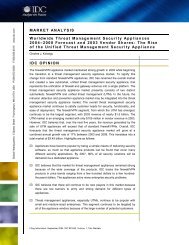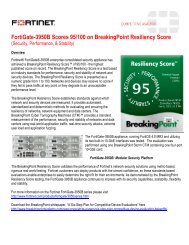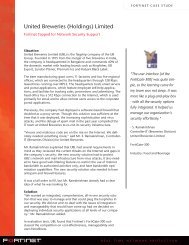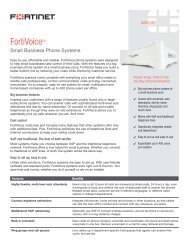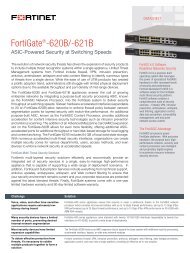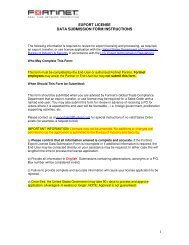FortiDDos DDoS Attack Mitigation Guide - Fortinet
FortiDDos DDoS Attack Mitigation Guide - Fortinet
FortiDDos DDoS Attack Mitigation Guide - Fortinet
You also want an ePaper? Increase the reach of your titles
YUMPU automatically turns print PDFs into web optimized ePapers that Google loves.
<strong>Attack</strong>s to test functionality and performance<br />
delivery. Normally sequence numbers are randomly chosen in a given connection.<br />
Once chosen, they follow a discipline. In a random sequence or acknowledgement<br />
number attack, these numbers are randomly chosen and varied. It can confuse the<br />
receiving end-point stack.<br />
TCP random window size<br />
TCP is a connection-based stateful protocol to complete datagram oriented IP<br />
protocol which it uses as an underlying protocol. It uses windowing to break large<br />
application packets to ensure proper end-to-end ordered delivery. The window size<br />
determines the number of bytes of data that can be sent before an acknowledgement<br />
from the receiver is necessary. In a random window size attack, the window sizes are<br />
randomly chosen and varied. It can confuse the receiving end-point stack.<br />
TCP random option value<br />
The TCP Options are located at the end of the TCP Header. These options have been<br />
used to enhance TCP protocol. TCP options include Maximum Segment Size (MSS),<br />
Window Scaling, Selective Acknowledgement (SACK), etc. In a random option value<br />
flood, the option values are changed randomly. Some of the combinations may be<br />
anomalous while some values may be anomalous too as they may be unassigned<br />
values.<br />
TCP random data length<br />
The length of TCP payload is dependent on the MTU (Maximum Transmission Unit)<br />
supported by the network, for normal ethernet the MTU is 1500. This is the maximum<br />
amount of data available to IP, TCP, and the application, it excludes the bytes for the<br />
ethernet header and trailer. From this 1500 you need to subtract bytes for the IP and<br />
TCP headers (normally 20 bytes each) leaving 1460 bytes available to the application.<br />
If the RFC1323 Timestamp option is used (fairly common nowadays) it extends the<br />
TCP header by 12 bytes leaving 1448 bytes. In a random data length attack, the<br />
payload size is randomly chosen.<br />
TCP checksum error flood<br />
TCP checksum field is the 16 bit one's complement of the one's complement sum of<br />
all 16 bit words in the header and text. The checksum also covers a 96 bit pseudo<br />
header conceptually prefixed to the TCP header. This pseudo header contains the<br />
Source Address, the Destination Address, the Protocol, and TCP length. This gives the<br />
TCP protection against misrouted segments. In a TCP checksum error flood, TCP<br />
segments with bad checksums are sent to overload the checksum validation logic.<br />
IP random identification flood<br />
The IP-Identification (IP-ID) field value in the IP header is used to uniquely identify the<br />
fragments of a particular datagram. Fragments of a particular datagram are assembled<br />
if they have the same source, destination, protocol, and Identifier. The IP identifier field<br />
Forti<strong>DDoS</strong> <strong>DDoS</strong> <strong>Attack</strong> <strong>Mitigation</strong> <strong>Guide</strong><br />
28-100-167076-20120501 31<br />
http://docs.fortinet.com/ • Feedback



